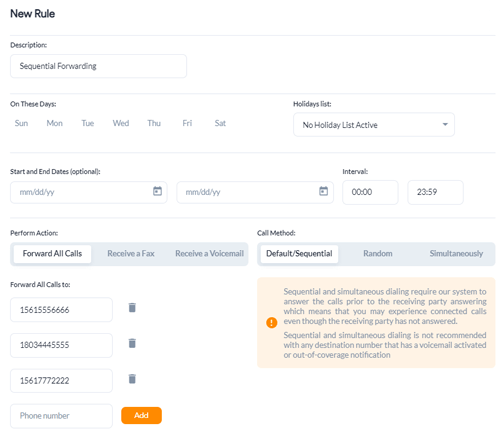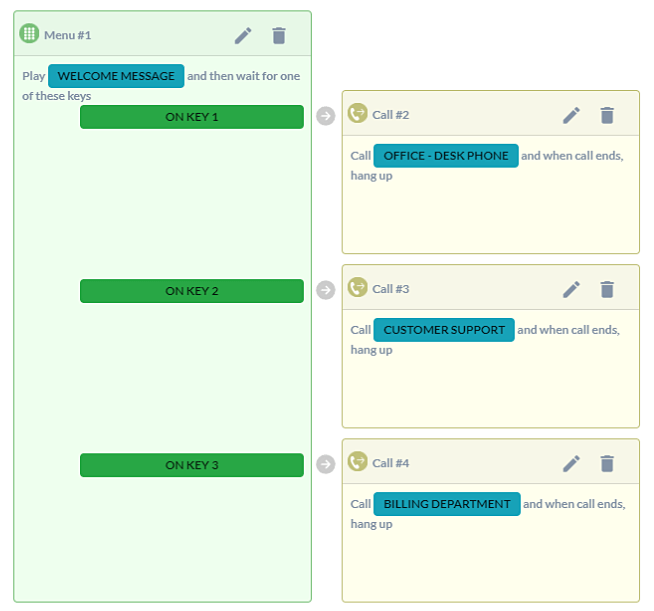The sales landscape is constantly changing and adapting to prospect preferences. That’s where inbound sales come in.
In this post, we will explore the fundamentals of inbound sales, why this strategy is important for businesses, and effective strategies to increase inbound sales. Whether you’re new to the concept or looking to enhance your existing sales approach, this guide will provide valuable insights to help you navigate the world of inbound sales and drive meaningful results for your business.
What is Inbound Sales?
The term “inbound sales” refers to a sales approach that focuses on attracting and engaging potential customers through various marketing and communication channels.
The inbound sales cycle typically occurs when interested parties reach out to your business expressing interest in your products or services. Here, prospects take the first step and begin the selling process, instead of your sales team.
But, this doesn’t mean your business sits back, waiting for warm leads to pop up.
In fact, a big part of inbound sales involves attracting potential customers using digital marketing strategies. And this is true whether you’re a B2C or B2B sales team. These types of marketing efforts typically focus on:
- Creating relevant, valuable content
- Generating leads
- Qualifying and nurturing leads
- Establishing trust and strong relationships with prospects
- Meeting the customer’s needs
- Providing tailored solutions and so on.
Note that an effective digital marketing strategy is meant to nurture inbound leads and guide prospects through the buyer’s journey. And the overall goal, of course, is to drive conversions and close sales.
An example of the inbound sales process:
A customer searching for a project management tool discovers your services through an ad, social media, or a blog post. After that, they’ll conduct research to see if your product fits their needs by viewing videos, reading case studies, and signing up for a demo. Your teams then call them to set up the demo and personalize the solution to their needs. As the prospect becomes more familiar with your brand and sees the value of your solution, they’ll reach the decision stage where they are ready to purchase.
This way inbound sales and lead generation work across marketing platforms and communication channels. Popular communication channels for inbound sales include:
Why Should Inbound Sales Matter to Businesses? [Benefits]
If you’re still wondering why inbound sales matter, here are the benefits of implementing this sales strategy:
1. Attract Qualified Leads
Creating valuable, targeted content that draws visitors to your website helps you attract leads who are genuinely interested in your services. And this means they are more likely to convert into paying customers.
2. Increase Conversion Rates and Sales
Understanding your audience’s pain points and challenges allows you to target them in your content and, more importantly, explain how prospects can solve them with your services. This not only gives inbound sales a more personalized feel, but also leads to higher conversion rates and increased sales.
3. Educate Buyer and Build Trust
Taking an informative and educational approach to the sales process helps build trust with potential customers. And by positioning yourself as a thought leader, you further demonstrate your brand’s credibility and authority in your industry, which further builds trust among your target audience.
4. Improve Customer Retention
Offering prospects ongoing support and resources keeps them engaged and satisfied through the sales process and beyond, leading to reduced churn and improved customer lifetime value (CLV).
5. Save on Sales Costs
Attracting customers organically using inbound marketing strategies allows you to reduce your sales costs. This is because inbound methods such as content marketing are typically more cost-effective than traditional outbound methods like cold-calling or attending trade shows.
Inbound Sales vs Outbound Sales
Outbound sales are essentially the opposite of inbound sales – meaning your sales team reaches out to leads who haven’t yet shown interest in your product. So, the entire selling process is different.
Let’s break it down further:
|
Inbound Sales |
Outbound Sales |
| Initiated By |
Interested prospects |
Sales agents |
| Lead’s Awareness / Interest |
Already aware of business. Showed interest in products / services. |
Little-to-no knowledge of business. Hasn’t previously expressed interest in products / services. |
| Strategies Used |
• Ads
• Blogs
• Webinars
• Demos
• Consultations
• Case studies, etc. |
• Cold calling
• Pitches / presentations
• Social selling
• Email campaigns
• Trade shows / networking events
• Direct mail, etc. |
| Pro / Con |
Pro: Better conversion rates
Con: Less control over selling process |
Pro: Expand business network, grow into new markets, more targeted
Con: Takes longer to close sales |
It’s important to note that neither one of these sales tactics is better than the other. The one you choose or prioritize all depends on your goals, business model, customer base, and so on.
Reviewing the Buyer’s Journey
Since prospects are the ones initiating the sales process, they have an entirely different buyer’s journey than those prospective leads who experience outbound selling techniques. For example, leveraging a LinkedIn email finder can be instrumental in identifying and connecting with prospects who demonstrate interest in your services, aligning seamlessly with the inbound sales approach.
By understanding the buyer’s journey, companies can align their sales and marketing efforts to effectively engage with prospects at each stage. Each stage provides insights into the decision-making process that potential customers go through before making a purchase.
Broadly, these are the 3 stages of the buyer’s journey:
• Awareness
The buyer realizes they have a problem or need and begins seeking information and potential solutions. They are conducting research and exploring various options.
• Consideration
The buyer has clearly defined their problem or need and is actively evaluating different solutions available in the market. They are comparing features, pricing, and evaluating the potential value of each solution.
• Decision
The buyer is ready to make a purchase decision. They have evaluated their options and are looking for the best solution that meets their needs and offers the most value.
Ultimately, by aligning your inbound sales strategies with the stages of the buyer’s journey, companies can build trust, provide value, and establish long-lasting relationships with their customers.
4 Stages of Inbound Sales
There are also different stages of inbound sales — from the seller / business’ perspective — which are interconnected with the buyer’s journey.
By aligning your sales strategies with the customer’s journey, you’ll deliver the right content, support, and engagement at the right time. This ensures a customer-centric approach that guides prospects through their decision-making process and maximizes the chances of converting them into loyal customers.

Here are the 4 stages of inbound sales:
1. Identify
Identify active, potential buyers who are likely to be a good fit for your product or service by determining your target audience behavior, frequent website visitors, etc.
Strategies:
-
- Develop buyer personas of your ideal customers based on demographics, behavior, and challenges
- Conduct research to identify active prospects, market needs, and competitive landscape
- Attract potential leads and capture contact info through content marketing, social media, and advertising
2. Connect
Initiate and establish a connection with your identified prospects by reaching out to them and starting a conversation.
Strategies:
-
- Tailor communication to each prospect’s pain points
- Demonstrate how your product or service provides a solution
- Utilize social media, email marketing, live chat, and so on to engage with prospects
3. Explore
Understand the prospect’s needs, challenges, and goals in more depth through active listening and thoughtful questioning.
Strategies:
-
- Ask open-ended questions to uncover pain points and understand unique requirements
- Conduct a needs assessment
- Determine how your product provides value and meets their needs
- Evaluate prospect responses and concerns to gather insights
4. Advise
Provide tailored recommendations and guidance to the prospect by positioning yourself as a trusted advisor who can help the prospect make an informed decision.
Strategies:
-
- Present a solution based on the information you have gathered
- Use product demos and case studies to showcase the value of your solution
- Address any concerns and provide relevant info to alleviate doubt
- Outline the next steps for the prospect
6 Ways to Increase Inbound Sales
Now that we’ve covered the basics of inbound sales, let’s discuss 6 strategies that you can use to increase your sales efforts.
Inbound Sales Strategies
- Include Valuable Materials On and Off Your Website
- Display Business Contact Info Clearly on Your Website
- Make it Easy for Prospects to Talk to Sales
- Conduct Pre-Call Research
- Lead Effective and Tailored Demos
- Follow-Up and Leverage Sales Enablement Resources
1. Include Valuable Materials On and Off Your Website
Active buyers only spend 17% of their time talking to sales teams and suppliers. This means, around 80% of their time is spent researching your products and services both on your website and offsite.
So, you must provide valuable and informative content on your website – such as blog posts, videos, and downloadable resources – to attract potential buyers. On top of that, you can broaden your audience and drive more traffic to your site through offsite guest blogging, partnerships, social media promotion, and so on.
By doing so, you can enhance engagement, build credibility, and ultimately contribute to the success of your sales efforts.
2. Display Business Contact Info Clearly on Your Website
Displaying your business phone number and contact information clearly on your website is an easy win for your sales team.
When visitors have quick access to your phone number and contact information, they are more likely to take action, such as making a call or submitting an inquiry. This can increase the likelihood of conversions, lead generation, and inbound sales.
If your business caters to an international audience, then make sure to display your international numbers in an organized manner. So, global prospects can contact you.
3. Make it Easy for Prospects to Talk to Sales
Along the same lines, you want to make it easy for prospects and leads to get in touch with sales. And this not only means displaying your local business number, but also offering omnichannel communication options to prospects.
For instance, you can set up live chat using software like Zoho SalesIQ or integrate click-to-call buttons and web callback options using providers like Global Call Forwarding.
By offering omnichannel contact options, you remove barriers and provide a seamless way for prospects to engage with your sales team. So, you encourage prospects to reach out, ask questions, and seek further information. And this ultimately leads to increased conversions and a more effective inbound sales process.
4. Conduct Pre-Call Research
Before engaging with a prospect, it’s important to conduct pre-call research and gather relevant information such as company, industry, and specific pain points. This allows you to approach the conversation with a deeper understanding of their needs and positions you as a trusted advisor.
Take time to research your prospect’s background and recent activities. This way, you can personalize the conversation, ask more targeted questions, and tailor your solutions to their unique challenges. Use our pre-call sales checklist to get a head start!
And with a VoIP integration for your CRM, you can place the call directly from one platform once you’ve completed your research, saving you time and effort.
5. Lead Effective and Tailored Demos
A well-executed demo provides prospects with a firsthand experience of your product. With customized demos, you can demonstrate how your solution solves specific pain points and aligns with their desired outcomes.
Effective demos build trust, highlight key features, and allow prospects to visualize how your solution can enhance their business. By delivering compelling and personalized demos, you significantly improve your chances of converting leads into satisfied customers and driving sales growth.
6. Follow-Up and Leverage Sales Enablement Resources
Following up promptly and consistently with potential customers shows your commitment and interest in their business. Utilizing sales enablement resources – such as case studies, product guides, and demos – provides valuable insights and support throughout the buyer’s journey by:
- Helping sales reps to address objections
- Providing additional information on products and services
- Guiding prospects towards making a purchase decision and more
Most importantly, sales enablement resources equip your sales team with the tools and information they need to effectively engage and convert prospects. So, you can nurture leads, build trust, and ultimately boost your inbound sales.
Improving Sales with Global Call Forwarding
As you can see, inbound sales play a pivotal role in modern sales strategies. Embracing this strategy’s power enables businesses to establish stronger customer relationships, increase conversions, and ultimately achieve long-term sales growth in today’s competitive marketplace.
And with the right tools and call center features, you can ensure your sales team’s and business’s success. Global Call Forwarding offers international business phone numbers, web callback services, click-to-call features, and VoIP CRM integrations.
To learn about how our solutions can help your inbound sales efforts, speak with our team of experts at (561) 908-6171 or chat with us online!




















